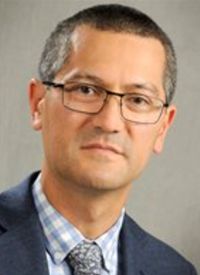Risk-Adapted Therapy Feasible in Newly Diagnosed Ultra High–Risk Myeloma
Centrally stratified risk-adapted clinical trials in patients with newly diagnosed multiple myeloma were shown to be feasible, addressing an unmet need and providing the opportunity for rapid clinical development of novel therapies.
Matthew Jenner, MBBS, MRCP, FRCPath

Centrally stratified risk-adapted clinical trials in patients with newly diagnosed multiple myeloma were shown to be feasible, addressing an unmet need and providing the opportunity for rapid clinical development of novel therapies, according to a poster presentation on the OPTIMUM MUK9 trial (NCT03188172) delivered during the 2nd European Myeloma Network Meeting.1
Utilizing an intelligent design, the trial showed the feasibility of central risk profiling in the time-sensitive setting of newly diagnosed multiple myeloma. Patients suspected to have newly diagnosed disease were permitted to enroll before undergoing biopsy to avoid repeat biopsy, and the majority, or 89%, were confirmed to have symptomatic multiple myeloma.
Moreover, the median risk status turnaround time was 18 days (IQR 13-22), which was noted to be well below the protocol-defined maximum limit of 8 weeks. Ninety-three percent of patients had central results that were successfully generated, with most of the technical failures caused by aspirate quality.
“OPTIMUM is generating important benchmark data for several dimensions of risk-adapted therapy,” lead study author Matthew Jenner, MBBS, MRCP, FRCPath, of the University Hospital Southampton National Health Service Foundation Trust, and colleagues, wrote. “[This is] the first trial in newly diagnosed multiple myeloma to use a Virtual/Digital comparator in a Bayesian Design. This is enabled by availability of molecularly matched patient data from the near-concurrent Myeloma XI trial [NCT01554852].”
Patients with newly diagnosed ultra high–risk multiple myeloma ad primary plasma cell leukemia (PCL) represent a population with a high unmet need and are underrepresented on clinical trials. Moreover, those who have double-hit and Gene Expression Profile High Risk signature disease are known to have a very short progression-free survival.
To address the need, investigators launched the prospective, multicenter, risk-stratified trial to evaluate a novel treatment strategy in patients with newly diagnosed ultra high–risk multiple myeloma and with PCL.
OPTIMUM MUK9 is comprised of 2 protocols: OPTIMUMscreen (MUK9A) and OPTIMUMtreat (MUK9B). Patients were recruited between September 2017 and July 2019, when the recruitment target of 108 patients with ultra high–risk multiple myeloma/PCL was reached. Investigators noted that recruitment was rapid, with recruitment completing 9 months ahead of schedule; this underscored the need for risk-adapted treatment protocols for fit patients with this disease.
A total of 462 patients with suspected newly diagnosed multiple myeloma from 39 hospitals in the United Kingdom and 10 patients with primary PCL were biopsied. Individuals had central
molecular profiling of their CD138-selected tumor material done; this consisted of IGH translocation, copy number alteration, and GEP SKY92 risk profiling. Patients were allowed to have 2 cycles of standard-of-care (SOC) bortezomib, thalidomide, and dexamethasone (VTD), while biopsy results were produced and no patient experienced progression during this phase.
A total of 138 patients were determined to have ultra high–risk multiple myeloma; of these patients, 19 were determined to be unfit and 11 patients withdrew. The remaining 108 patients then went onto the OPTIMUMtreat protocol where they received daratumumab (Darzalex) plus cyclophosphamide, bortezomib (Velcade), lenalidomide (Revlimid), and dexamethasone (Dara-CVRd) as induction treatment for 4 cycles and bortezomib-augmented, single high-dose melphalan and autologous stem cell transplantation (ASCT). They then received Dara-VRd consolidation therapy for 6 cycles, followed by Dara-VR consolidation for 12 cycles, and Dara-R as maintenance treatment until either progressive disease or intolerable toxicity.
A total of 251 patients determined to not have high risk disease comprised a molecularly characterized real-world cohort that were followed up through received SOC first- and second-line treatment, which could include VTD, and high-dose melphalan and ASCT.
A program of translational studies is also being done to acquire a better understanding of high-risk multiple myeloma. Longitudinal central biosampling is being done to learn more about genomics, minimal residual disease (MRD), serum in terms of central response and immunoparesis, and bone marrow immune profiling.
Moreover, multicenter whole body diffusion-weighted MRI will be used to do imaging MRD and examine relapse patterns. Another study will be dedicated to examining the patient and physician perspective on this approach by looking at patient-reported outcomes/quality of life and performing a patient and physician futility assessment. “This will provide future benchmark comparator datasets for the community,” study authors wrote.
The first data from the trial are expected in Q2 2021.
Reference
- Jenner M, Hall A, Sherborne A, et al. Tailoring therapy for newly diagnosed ultra high-risk myeloma patients – first results of the risk-adapted UMKRA OPTIMUM (MUK9) trial. Presented at: 2nd European Myeloma Network Meeting; March 3-6, 2021; Virtual. Abstract P31.



